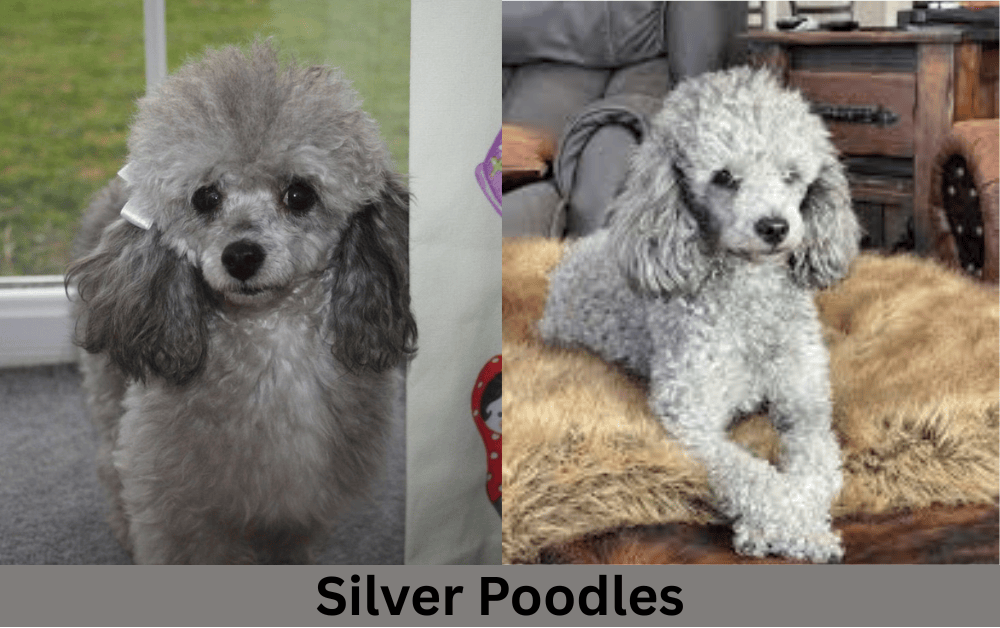Introduction
Poodles have a long and interesting history. Breeders first developed them in Germany as water retrievers, and then they became popular in France. Silver Poodles show all the wonderful traits of the breed, including intelligence, loyalty, and a hypoallergenic coat. This guide will tell you everything you need to know if you’re thinking about adding a Silver Poodle to your family.
Silver Poodle Quick Facts Table
| Category | Details |
|---|---|
| Origin | Germany, later popularized in France |
| Coat Color | Silver (born black, fades to silver over 2-3 years) |
| Coat Type | Curly, dense, and hypoallergenic |
| Sizes | Toy, Miniature, Standard |
| Height | Toy: <10 inches; Miniature: 10-15 inches; Standard: 15-24 inches |
| Weight | Toy: 4-6 lbs; Miniature: 10-20 lbs; Standard: 40-70 lbs |
| Lifespan | 12-15 years (with proper care) |
| Temperament | Intelligent, loyal, playful, affectionate, and emotionally sensitive |
| Trainability | Highly trainable, excels in obedience and agility training |
| Exercise Needs | 30-60 minutes daily (walks, playtime, mental stimulation) |
| Grooming Needs | Brush daily; professional grooming every 6-8 weeks |
| Health Concerns | Hip dysplasia, progressive retinal atrophy (PRA), Addison’s disease, bloat |
| Diet | High-quality protein-rich dog food; avoid overfeeding |
| Good with Kids | Yes, excellent with children |
| Good with Other Pets | Yes, especially if socialized early |
| Apartment-Friendly | Yes (Toy and Miniature); Standard Poodles may need more space |
| Recognition | Recognized by the American Kennel Club (AKC) |
| Price | $1,000 to $5,000 (depending on breeder, pedigree, and location) |
History and Origin of Silver Poodles
The story of Silver Poodles connects directly to the history of Poodles. Originally, Poodles worked as water retrievers in Germany, where they helped hunters fetch ducks and other waterfowl. When Poodles became popular in France during the 18th century, breeders focused on improving their looks and personality.
Through selective breeding, Silver Poodles emerged as breeders aimed to create specific coat colors in Miniature and Toy Poodles. Their unique silver shade comes from a recessive gene that slowly lightens black fur over 2-3 years. Dog lovers quickly noticed Silver Poodles for their stunning color and elegant appearance. Breeders carefully chose Poodles with the best traits, ensuring Silver Poodles kept their beauty and high quality. Today, Silver Poodles rank among the top 10 most admired Poodle variations because of their elegance and charm. This careful breeding process has made them a favorite among dog enthusiasts worldwide.
Recognition of Silver Poodles
The American Kennel Club (AKC) officially recognizes Silver Poodles. The AKC includes silver as an accepted Poodle color and allows these dogs to participate in competitions. To be considered a true Silver Poodle, a dog must have an even silver coat without large black or white patches.
Silver Poodle Genetics
If a Silver Poodle breeds with a Poodle of another color, the litter may include puppies with different shades. These shades can include cream poodle, gray poodle, or even a black Poodle. Responsible breeders choose the parent dogs carefully to keep the silver coat and protect the puppies’ health.
Silver Poodle Lifespan
The lifespan of a silver poodle is usually between 12 and 15 years. They are generally healthy dogs but need proper care and regular vet check-ups. A balanced diet and exercise help them live a long and happy life.
Silver Poodle Physical Appearance

These beautiful poodles are famous for their striking coats, which change color as they age. They are born black, but their fur starts to lighten between six weeks and six months. By the time they turn two, their coat fully develops into a silver shade.
Recessive Silver Coloration
A recessive gene causes the silver color in Poodles. A poodle puppy must inherit this gene from both parents to be born as a silver poodle. Some puppies may not turn completely silver even when two Silver Poodles are bred. Instead, they might develop shades of silver beige, cream, or darker gray. This unpredictability makes them even more fascinating.
Coat Texture
Silver Poodles have soft, curly coats that need regular maintenance. These poodles are a great choice for people with allergies because their fur sheds very little. Their fur keeps growing, and they need regular grooming to prevent mats and tangles.
Size Variation
Silver Poodles come in three different sizes:
- Standard Silver Poodle: Over 15 inches tall, weighing 40-70 lbs.
- Miniature Silver Poodle: 10-15 inches tall, weighing 10-20 lbs.
- Toy Silver Poodle: Under 10 inches tall, weighing 4-6 lbs.
Facial Features
These beautiful Poodles have dark, expressive eyes, a straight muzzle, and long floppy ears covered in curls. They have well-proportioned, athletic, and elegant bodies. They often have a dignified and confident expression because they are highly alert and intelligent.
Silver Poodle Temperament

- Loyal and affectionate: Silver Poodles form strong bonds with their owners and love being part of the family.
- Highly intelligent: Poodles rank as the second most intelligent dog breed, just behind Border Collies.
- Energetic and playful: These dogs need plenty of exercise and mental stimulation to stay happy.
- Good with children and pets: Silver Poodles usually get along well with kids and other animals, making them excellent family pets.
- Emotionally sensitive: They can sense their owner’s emotions and respond to changes in the household.
Silver Poodles are very smart, so they enjoy puzzle toys, obedience training, and playing with people. If they don’t get enough mental exercise, they might start barking too much or chewing on things they shouldn’t.
Silver Poodle Suitability as a Pet
Silver Poodles make fantastic pets for many types of owners. Their intelligence, adaptability, and affectionate nature help them fit into a wide range of households. They do well in active families, homes with large yards, and even multi-pet households. They also suit people with allergies since their fur is hypoallergenic.
Even first-time dog owners can easily care for this Poodle because these dogs love to learn and please their owners. However, they do require regular grooming and daily exercise. If you’re considering getting one, be prepared to spend time keeping them physically and mentally engaged.
Health Issues In Silver Poodles

Silver poodles stay healthy, but they can develop certain genetic health issues like all other poodles. These health issues are sometimes genetic, and some develop as the poodle grows old. Some common health issues of silver poodles are mentioned here.
Common Health Issues
- Hip Dysplasia – A condition where the hip joint doesn’t fit correctly, leading to arthritis.
- Progressive Retinal Atrophy (PRA) – An eye disorder that slowly causes blindness.
- Addison’s Disease – A hormonal disorder that lowers energy levels and affects appetite.
- Bloat (Gastric Dilatation-Volvulus) – A serious stomach condition that can be deadly.
- Epilepsy – Some Poodles suffer from seizures, but medication often controls them.
Silver Poodle Grooming Tips
Groom your Poodle regularly to keep them clean, healthy, and stylish. Their curly coat grows fast and often forms mats without care. Brush them often and pick the best poodle clips to match the season or your dog’s lifestyle. Some clips work great for active dogs, while others show off their fancy side. Grooming also helps you check their skin and catch problems early. Start a grooming routine when your Poodle is young, so they feel calm and happy during each session. Whether you clip at home or go to a groomer, your Poodle stays fresh and comfortable with the right care.
These beautiful Poodles require regular grooming to keep their coats looking beautiful and healthy. Their curly fur tangles and mats easily without proper care. Here are some essential grooming steps:
- Brushing – Brush your Poodle daily to prevent knots and remove loose hairs. A slicker brush or comb works best for their curls.
- Bathing – Poodle bathing is very important, and it should be given every 4-6 weeks using a gentle dog shampoo. This keeps their coat clean and helps maintain their silver shine.
- Trimming – Visit a professional groomer every 6-8 weeks for a trim. Many Poodle owners prefer stylish cuts like the “puppy clip” or “continental clip.”
- Ear Cleaning – Poodle ear cleaning is important because their floppy ears can trap moisture and dirt. Check and clean their ears regularly to help prevent infections.
- Nail Trimming – Trim their nails every few weeks to prevent discomfort and overgrowth.
- Dental Care – Brush their teeth several times a week to prevent tartar buildup and bad breath.
How much do silver poodles cost?
Where to buy a Silver Poodle?
If you want to buy a Silver Poodle puppy, find a reputable breeder. Choose breeders who do health testing and keep their dogs in a clean space. Check the American Kennel Club (AKC) website or breed clubs for trusted breeders. Visit the breeder in person to see the puppy’s living conditions and meet the parents. Avoid puppy mills or pet stores because they often sell unhealthy dogs.
You can also adopt from a rescue or shelter. Many Poodles, including Silver Poodles, need loving homes. Check local shelters or Poodle rescue groups for available dogs. Adoption costs less than buying from a breeder and helps a dog in need.
Conclusion
Silver Poodles are rare, beautiful, and intelligent dogs that make excellent companions. Their unique silver-gray coat starts black and gradually lightens as they grow, making them stand out from other Poodles. These dogs form strong bonds with their families, love to play, and learn quickly, which makes them great pets for both first-time and experienced owners. Silver Poodles need regular grooming and daily exercise, but owners find their loving personality and loyalty worth the effort. These dogs adapt well to different homes, whether apartments or large houses. Their hypoallergenic coat works well for people with allergies.
If you want a smart, elegant, and loving dog, consider getting a Silver Poodle. Pick a responsible breeder who tests their dogs’ health, or adopt one from a rescue center. When you give your Silver Poodle good care, training, and plenty of love, you will enjoy a happy, loyal friend for 12 to 15 years.
FAQs About Silver Poodles
How can I identify a Silver Poodle puppy?
Silver Poodle puppies are typically born with black coats. You will notice lighter hairs on the face and paws as the poodle grows around six weeks of age. This process indicates that the silvering process has begun. This gradual color change continues to a beautiful silver hue by the time they reach two years.
Do silver poodles’ coats change color as they age?
Yes, silver Poodles coat change color as they grow. They are born black and turn silver by the time they are about two years old. After that, their coat color stays mostly the same, but it may lighten slightly with age or due to the environment.
Are Silver Poodles hypoallergenic?
Yes, silver poodles are hypoallergenic. They are often called hypoallergenic because they shed very little and are good for people with allergic problems. However, some people may still have allergies. Allergy sufferers should spend time with a Poodle before getting one.
Are Silver Poodles recognized by major kennel clubs?
Yes, major kennel clubs like the American Kennel Club (AKC) recognize silver as an official Poodle color. This means Silver Poodles can participate in conformation shows and competitions, provided they meet other breed standards.
Do Silver Poodles require special grooming compared to other Poodles?
No, Silver poodles do not require special grooming compared to other poodles. All poodles have thick, curly coats that need regular grooming to avoid tangles. Keeping a Silver Poodle’s coat shiny may require special shampoos or treatments to enhance its color.
Are Silver Poodles prone to specific health issues?
No, silver Poodles are not prone to specific health issues. They share the same health concerns as other Poodles, such as hip dysplasia and progressive retinal atrophy. Their unique coloration doesn’t predispose them to additional health problems. Regular veterinary check-ups and a healthy lifestyle are essential for their well-being.
How does the temperament of Silver Poodles compare to other Poodle colors?
A Poodle’s temperament is more influenced by genetics and upbringing than coat color. Silver Poodles are known for their intelligence, playfulness, and affectionate nature, traits common across the Poodle breed.
Can two non-silver Poodles produce Silver Poodle puppies?
Yes, it’s possible if both parents carry the recessive gene for the silver coloration. However, predicting coat color can be complex due to various genetic factors. Consulting with a knowledgeable breeder can provide more insight into potential outcomes.
How does the size of a Silver Poodle affect its lifespan?
Smaller Poodles, like Toy and Miniature Poodles, usually live longer than Standard Poodles. No matter the size, good care, proper food, and regular vet checkups help your Silver Poodle live a long, healthy life.
What’s the difference between silver and blue Poodle coat colors?
Both silver and blue Poodles are born with black coats. Silver Poodles begin showing lighter hairs around six weeks, with their coat lightening significantly by two years. Blue Poodles experience a more gradual and less dramatic lightning, resulting in a dark steel gray shade.

